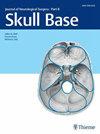学员复杂颅底入路的一步一步解剖:双额跨基底入路的外科解剖、手术原理和说明性病例
IF 0.9
4区 医学
Q3 Medicine
引用次数: 0
摘要
经基底入路传统上采用双冠状头皮切口联合双额开颅建立硬膜外中线颅底工作通道。依靠颅面截骨术,该入路可扩展至鼻腔和鼻窦,并可用于切除特别复杂的鼻窦和中线颅底肿瘤。鉴于其在术语和互操作技术上的差异,我们提出了一个实用的,以操作为导向的指导学员执行这种方法。方法在显微镜下和内镜下对3例注射了乳胶的福尔马林固定标本进行解剖。对经颅-经基底入路进行逐步解剖,并进行常见的修改,用三维摄影记录,并辅以代表性病例应用。结果传统的双额开颅经颅底入路可为前颅窝和中央颅底提供宽的硬膜外通路。颅面截骨术的加入进一步扩大了进入鼻窦、斜坡和颅颈交界处的通道。主要步骤包括患者体位、双冠状皮肤切口、颅周移植物摘取、双额开颅、眶缘截骨、蝶窦切开术、双侧筛切除术和鞍区显微外科解剖。基底上矢状窦结扎和硬膜切开允许硬膜内暴露。重建技术也进行了讨论。结论虽然跨基底入路有丰富的历史描述、例证和修改,但其逐步的表现对年轻一代的受训者来说可能是相对未知和不清楚的。我们提供了一个全面的指导,以优化在外科解剖实验室中对跨基底入路及其适应症的熟悉,掌握相关的显微外科解剖,同时为学习和参与手术室做好准备。本文章由计算机程序翻译,如有差异,请以英文原文为准。
Anatomical Step-by-Step Dissection of Complex Skull Base Approaches for Trainees: Surgical Anatomy of the Bifrontal Transbasal Approach, Surgical Principles, and Illustrative Cases
Abstract Introduction The transbasal approach traditionally uses a bicoronal scalp incision with bifrontal craniotomy to establish an extradural midline skull base working corridor. Depending on additional craniofacial osteotomies, this approach can expand its reach to the nasal cavity and paranasal sinuses and may be employed for the resection of particularly complex sinonasal and midline skull base tumors. Given its discrepancy in nomenclature and differences in interoperator technique, we propose a practical, operatively oriented guide for trainees performing this approach. Methods Three formalin-fixed, latex-injected specimens were dissected under microscopic magnification and endoscopic-assisted visualization. Stepwise dissections of the transcranial-transbasal approach with common modifications were performed, documented with three-dimensional photography, and supplemented with representative case applications. Results The traditional transbasal approach via bifrontal craniotomy affords wide extradural access to the anterior cranial fossa and central skull base. The addition of craniofacial osteotomies further expands access into the sinonasal cavities, clivus, and craniocervical junction. Key steps described include patient positioning, bicoronal skin incision, pericranial graft harvest, bifrontal craniotomy, orbital rim osteotomy, sphenoidotomy, bilateral ethmoidectomies, and microsurgical dissection of the sellar region. Basal superior sagittal sinus ligation and durotomy allow for intradural exposure. Reconstruction techniques are also discussed. Conclusion While the transbasal approach is rich with historical descriptions, illustrations, and modifications, its stepwise performance may be relatively unknown and unclear to younger generations of trainees. We present a comprehensive guide to optimize familiarity with the transbasal approach and its indications in the surgical anatomy laboratory, mastery of the relevant microsurgical anatomy, and simultaneous preparation for learning and participation in the operating room.
求助全文
通过发布文献求助,成功后即可免费获取论文全文。
去求助
来源期刊

Journal of Neurological Surgery Part B: Skull Base
CLINICAL NEUROLOGY-SURGERY
CiteScore
2.20
自引率
0.00%
发文量
516
期刊介绍:
The Journal of Neurological Surgery Part B: Skull Base (JNLS B) is a major publication from the world''s leading publisher in neurosurgery. JNLS B currently serves as the official organ of several national and international neurosurgery and skull base societies.
JNLS B is a peer-reviewed journal publishing original research, review articles, and technical notes covering all aspects of neurological surgery. The focus of JNLS B includes microsurgery as well as the latest minimally invasive techniques, such as stereotactic-guided surgery, endoscopy, and endovascular procedures. JNLS B is devoted to the techniques and procedures of skull base surgery.
 求助内容:
求助内容: 应助结果提醒方式:
应助结果提醒方式:


